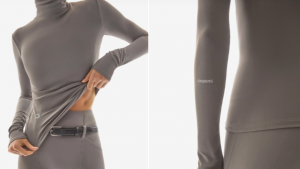What if you could find the perfect model for your clothes, without having to trawl through catalogues and set up photoshoots? If Lalaland is to be believed, you just need to design her.
The Dutch tech start-up is on a mission to make the web a more diverse, inclusive place by using AI to generate photorealistic fashion models. These customised, full-body models are created in a fraction of the time it takes to set up a photoshoot – in fact, Lalaland estimates they can achieve at least 70%-80% cost reductions on content production costs for traditional on-model photography.
Lalaland leverages neural networks to generate the models via their Genesis Meta Model Creator tool. They can be configured for every conceivable body shape and size, taking factors like age, height, and ethnicity into account.
This is a boon for brands because the fashion industry lacks inclusivity. Body diversity is seldom recognised, and ableism is the norm. In fact, one of the challenges Lalaland faced was making models more like real people, with imperfections, wrinkles, asymmetrical features and more.
“We invested two years in the development of the Meta Model Creator and making our models look like real humans,” says Harold Smeeman, co-founder and CCO of the company.
Thanks to Lalaland, brands will now be able to show their collections on models that look just like “real” people – an important gain in industry inclined to tell us what we should look like rather than working with who we really are.
Lalaland is also nudging the fashion industry towards greater sustainability by helping to reduce the waste generated by returns, as well as reducing shipments. The number of garments produced every year has doubled since 2000 and it exceeded 100 billion for the first time in 2014. An estimated 92 million tons of textile waste is created every year. The cost to companies is huge, and this alone should persuade brands to show up for Lalaland’s virtual fittings.
Another advantage is the new business models that are opening up. For example, brands can now design their garments virtually, and produce them only when they are sold. “Instead of producing 10 000 items for their collection, which may or may not find buyers, they wait until they receive an order and produce and deliver the item within five days,” says Smeeman.
Working with Dutch brands has proved instructive – return rates have decreased by 10-15% and conversion rates as well as click-through rates have been higher. “Our models have even performed better than real models,” Smeeman points out.
While he believes that real models will still hold out the promise of aspirational beauty in campaign images, adverts and TV commercials, the average consumer wants to know what clothes will look like on them, not on 25-year-old slim Caucasians. This was the rationale behind Lalaland’s business model, along with preventing brands from having to find nine different models to shoot garments for three different sizes and complexions.
Teasingly named after the fanciful ‘la-la land’ of the imagination (and not the Hollywood movie starring Emma Stone), Lalaland is creating an illusion of reality that’s better than reality itself. Winner of the Philips Innovation Award 2020 and one of the two recipients of the Tommy Hilfiger Fashion Frontier Challenge, which highlights social innovation, the company is disrupting apparel web shops and setting new e-commerce standards.
There’s a southern African connection, too – the company was co-founded by Michael Musandu, who was born in Zimbabwe and raised in South Africa. Musandu found it difficult to shop online due to a lack of representation, which drove him to want to design for greater diversity. Social empowerment is at heart of the company, which is even exploring fashion in the metaverse with selected clients.
“In the future, you may be able to own your own digital model, for whom brands can pay a fee for use,” says Smeeman, adding that Lalaland envisages NFTs that lead to the creation of a community of virtual fashion models, with virtual catwalks and branded stores.
Read more:
Nine climate-conscious fashion designers showcase at COP26.
Credits: Lalaland













